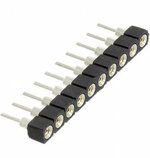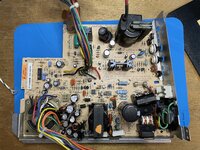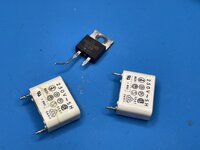Good stuff. One thing to think about - when you replace the optocoupler - I think they are possible to damage with soldering temperature, and I think that’s why they are socketed in the original Mac/Mac Plus analog board.
So, the last optocoupler I fitted to a Classic, I took a row of pin header sockets (photo below) and snapped off two rows of three, to make a six-pin IC socket in effect. The two rows are widely-spaced, so I guess a regular IC socket won’t fit.
Now it’s easy to change the optocoupler and I know it won’t be damaged by soldering Also seems a little less temperature-sensitive
Also seems a little less temperature-sensitive
So, the last optocoupler I fitted to a Classic, I took a row of pin header sockets (photo below) and snapped off two rows of three, to make a six-pin IC socket in effect. The two rows are widely-spaced, so I guess a regular IC socket won’t fit.
Now it’s easy to change the optocoupler and I know it won’t be damaged by soldering




